Gallic misunderstanding
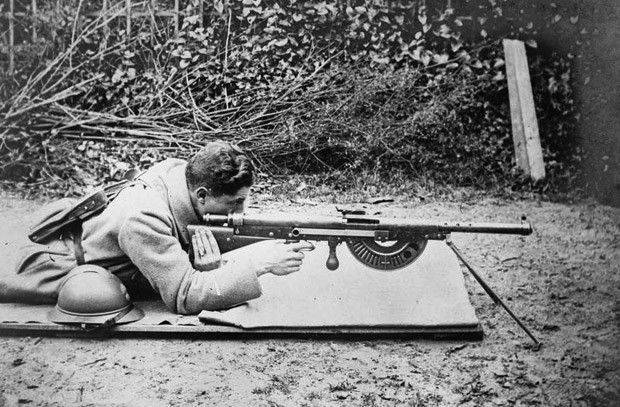
French weapon victories - unyielding courage of strange construction
By the beginning of the Great War, the German command and officers did not hide the scornful attitude towards the French army, associating it with the “Gallic rooster” - it was assumed that she was just as hot-tempered and loud, but in fact weak and frightened. But already in the first battles, the French soldiers confirmed the long-standing reputation of staunch and courageous fighters, sincerely ready for self-sacrifice in the name of the motherland. Their high combat qualities turned out to be more valuable because they had to fight this time with practically the worst weapon of all that was in the arsenals of both allies and opponents. The main weapon of the French soldier - the 8-mm rifle "Lebel-Berthier" - could not be compared with the German "Mauser M.98", in many ways yielding both to the Russian "trilinear" and the Japanese "Arisack Type 38" and the American " Springfield M.1903 ”, and many even attributed the“ Shosha ”machine gun to the category of weapons curiosities. Nevertheless, since the French infantrymen were doomed to use it (although they tried to replace trophy or allied forces at the first opportunity), it was the “weapon of victory” of the Great War that ultimately played a decisive role in the French army.
Child of the collective mind
History Lebel-Berthier rifles can serve as a good illustration of the same Gallic fervor, passion for not very thoughtful undertakings, none of which are brought to the end. At first, the French military department adopted the single-shot rifle of the Basil Gras system (1874), then this rifle was hastily remade into the shop Gra-Kropachek (1878 — 1884). However, less than two years later, it took the following modernization of the design - under the new cartridge with smokeless powder. Thus arose the adopted Nicole Lebel rifle, which, in turn, through 11 years had to be converted into the Lebel-Berthier system.
The original model for all of these structures — the single-shot rifle of the Gra system with a bolt-bolt mechanism — was exceptionally good for its time. It was distinguished by excellent ballistic qualities of the shot, the simplicity of the shutter, which had no threaded connections, the reliability of the design, and the convenience of working with a closed bayonet. In the period of 1878 — 1884, the “Gra” rifle was supplied with a tubular under-barrel magazine on 8 with cartridges of Alfred Kropachek's design, without changing the mechanism of the bolt group. The rifle received the name "Gra system - Kropachek" and was also considered quite successful.
However, the development of nitrocellulose (smokeless) gunpowder by the French chemist Viel opened up new horizons for small arms. Smokeless powder created a significantly greater energy of the shot than the smoke, less polluted the barrel with carbon deposits, had greater stability during storage and with a sharp temperature difference in field conditions. This military-technical breakthrough caused a quick reaction from the French General Staff.
Soon, a technical commission was formed under the leadership of General B. Tramont, which was charged with creating a new gun on the basis of the Gra-Kropachek infantry rifle, using a new, smaller caliber cartridge with smokeless powder. The 8-mm caliber cartridge (instead of the 11-mm ammunition for the Basil Gras model) was developed by the head of the Paris Rifle School, Colonel Nicolas Lebel. He also led the military trials of the newly created rifle, which received the unofficial name "Fusil Lebel" - Lebel rifle.
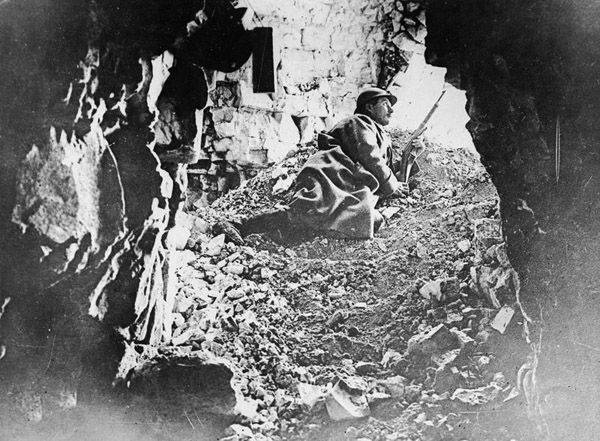
According to all weapons experts, according to the tactical and technical characteristics, it could be considered obsolete at the time of adoption. The reliable lock of the Gra system in the model of Lebel was “modernized” in the opposite direction: now it could not be disassembled without a screwdriver - the battle larva began to fasten on the stem with a special screw. The simple, though rough, fuse of the Gra-Kropachek rifle in the Fusil Lebel trigger mechanism was removed altogether: it was assumed that the soldiers would carry a rifle with a magazine full, but an empty chamber. At the same time, Lebel’s rifle did not save the very archaic feature of the Gra-Kropachek system, a long grenade of the 8 magazine, which changed the balance of the gun when emptying, while slowly reloading one cartridge, requiring regular and thorough cleaning.
After being put into service in 1886, the Lebel Mle.1886 rifle was released in a small series and brought to the “mind” for several years. After the "cosmetic" improvements, starting with the 1893 year, this gun was transferred to mass production and released until the 1920 year. The total release of Lebel rifles was about 2,5 million units.
Railroad Modernization
The flaws of the Lebel M.1886 / 93 showed up as soon as it hit the troops. Already in 1887, the French cavalry rebelled, the command of which declared that even a shortened rifle was unsuitable for effective use, primarily because of the inconvenience of the rider’s loading of the tubular rifle through a single cartridge cartridge.
It is not clear why this happened, but the next modernization of the Lebel gun was entrusted to the engineer of the Algiers Railway Emil Bertier. The main tactical and technical task was, obviously, to change the recharge pattern while maintaining the design features of the barrel and the slide group of the Lebel M.1886 / 93 model. As a result of not too complex design solutions, in 1890, a carbine for cavalry with a short barrel (450 mm) was adopted for use. Army certification this gun received in 1892 year and was named Fusil Berthier M.1892.
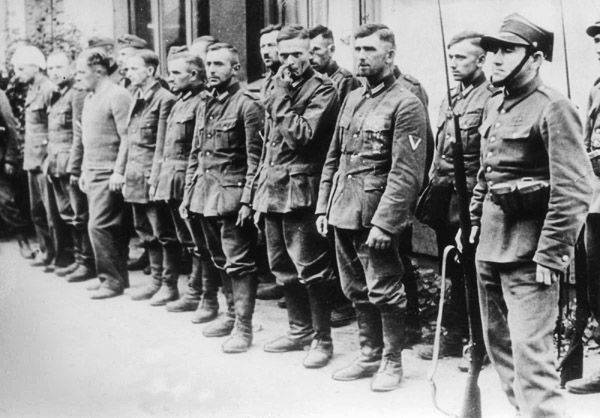
From the original model of Lebel, Berthier's carbine was distinguished by the design of a rifle box with a change in reloading on the bundle system borrowed from the Mannlicher rifle. Emil Berthier, however, simplified (for the better) the Mannlicher cartridge pack, which had constructively different “top” and “bottom” and could only be sent in one position. Berthier's pack was symmetrical and the cavalryman, holding the horse and opening the bolt, could in one motion send the carton to the 3 cartridge to the store. The carbine also received a new, solid (like the Russian “trilinea”) wooden box, a new sight and a long shutter handle, bent down. In the period 1902 — 1907, a family of lightweight rifles for the French colonial forces, which differed only in barrel length, was created on the basis of Fusil Berthier M.1892.
With the beginning of the Great War, it became obvious that the “Lebel M.1886 / 93” rifle lost significantly in reloading speed and, consequently, in the rate of fire of the German “Mauser M.98”. In this regard, the French General Staff decided to transfer the production capacity occupied by the release of Fusil Lebel M.1886 / 93 to the so-called "Senegalese" version of the Berthier rifle (modernization of the 1907 of the year).
At the beginning of the 1915 of the year, fearing the weapon "hunger", France placed an order for 200 thousands of rifles "Berthier M.1907 / 1915" in the United States at the facilities of the Remington company. However, since there was no urgent need for them, the order was fulfilled only by half, and even most of the rifles produced were sold out in the USA and Canada.
In 1916, the Berthier rifle was again upgraded, this time final. The gun, which had a characteristic silhouette before that because of the “underbelly” in front of the trigger, was protruded from it by an integral metal magazine. The rifle's appearance was completely disfigured, but the fighting qualities improved - the pack began to place a pack not on 3, but on 5 cartridges. Also, the main drawback of bundle shops was eliminated - a window opened from below for extracting a pack: the store began to hide behind an automatically opening lid.
Archaic collection
The rifle “Lebel M.1886 / 93” and the rifle “Berthier M.1907 / 16” were, in fact, one design, in which changes were made from series to series that could not, in general, drastically improve. To his main opponent, the German rifle Mauser M.98, the Lebel-Berthier rifle was inferior across the entire spectrum of characteristics, both combat and operational.
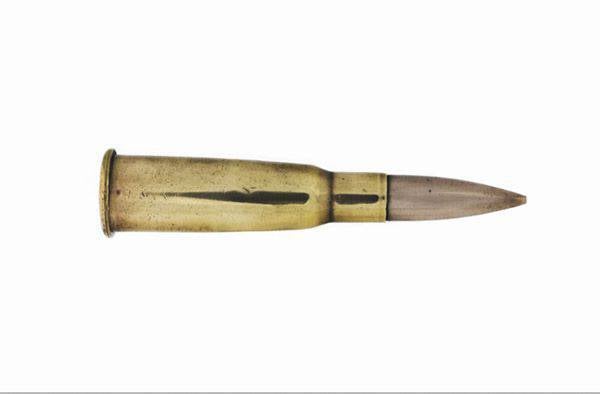
In the latest version of 1916, the French rifle received the longest barrel - 803 mm (against 600 mm from the "Mauser"), which was already an obvious anachronism. With a regular "open" sight, it did not give advantages in the range of the shot, but it hampered the actions of the fighter in the narrow opening of the trench. The archaic sector sight of the French rifle was easily deformed. The fuse was practically absent, it was replaced by the so-called safety block of the striker, which deformed during the descent the cartridge cap. The safety wooden lining on the barrel was short - with intensive shooting, the fighter could burn his fingers on a red-hot barrel. Upper swivel on the rifle's bed (for attaching the shoulder strap-shoulder strap) was completely absent, it was replaced by the so-called running ring, which was almost in the middle of the gun, which made it very uncomfortable to wear Fusil Lebel on the strap.
The lock “Lebel - Berthier”, as already mentioned, could not be disassembled without a screwdriver, but it was not in the “secret” of the butt - the fighter had to wear a screwdriver in a special compartment of the cartridge pouch. There was also no provision for a permanent (permanent) fastening of the ramrod, and the assembly of this necessary tool was supposed to be moved in the train. One of the characteristic details of the Lebel-Berthier rifle looked simply curious - the special metal "mustache" on top of the armory came from the "Napoleonic wars" and was intended to make guns into the "goats" during the halt.
The shot from “Lebel - Berthier”, although not very significant, was inferior in terms of a number of characteristics (range and flatness) to “Mauser M.98”. The French gun, among other things, “let down” the archaic welt cartridge, which gave the 8-mm bullet an initial speed slightly higher than 700 m / s versus 755 m / s in Mauser’s even the first series.
Small parties "Lebel - Berthier" during the war came to the Eastern Front, but did not enjoy the success of the Russian soldiers, who at the slightest opportunity tried to get rid of them. The Russian expeditionary corps in France, in choosing an infantry model, had no alternative.
Curiosities of Innovation
A light machine gun, and according to the French classification, an automatic rifle, the Shosh system (with an emphasis on the last syllable) refers to those few types of weapons that, depending on the point of view, can be called promising innovation or a strange weapon curiosity.
From a positive point of view, the “Shosh” machine gun, as it was classified in the Russian army, is undoubtedly a bold, though unsuccessful attempt to create the first French assault rifle. Subsequently, this idea was successfully implemented in Russia by the general V. G. Fedorov in his famous “automaton” for a modern 6,5-mm cartridge. The French were less happy in this business, largely because of the archaic welt cartridge (8 × 50-mm R Lebel) with a tapered sleeve.
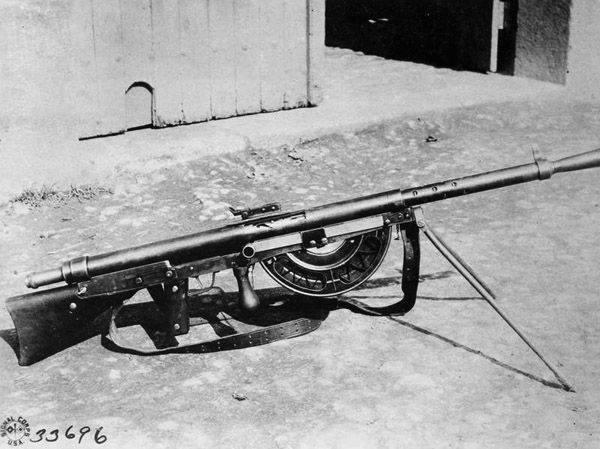
A critical eye will not see any merits in a French machine gun. "Shosh" really proved to be ineffective, with a very low rate of fire, inconvenient and technically unreliable. “The worst of the worst” - such a definition can sometimes be read about it in weapon research.
The Shosh machine gun also began to develop spontaneously, in response to the global trend to create automatic weapon systems. The basis of the future automatic rifle (and the French created it) was taken nowhere more unclaimed and potentially unsuccessful machine gun system of the Austro-Hungarian designer Rudolf Frommer, based on the recoil energy of the barrel with a long stroke. For quick-fire weapons, this scheme is the most undesirable because it leads to increased vibration. However, the French opted for it.
The new system was created by a design triumvirate: Army engineers Shosh and Sutte together with the general director of the engineering company Gladiator (Ribineol). By the middle of 1915, the manual machine gun was tested and put into service under the designation Chauchat CSRG Model 1915, and Gladiator received the first government order.
The tactical and technical characteristics of the new weapon were at the level “below the lowest”. Perhaps the only positive quality of the Shosh was a small weight - no more than 9,5 kg with a full box magazine on 20 cartridges and a bipod. Although here he did not become a “champion”: the Danish light machine gun “Madsen”, which had excellent combat and reliable automatics, weighed no more than 8,95 kg.
The operation of the automatics with a long barrel stroke had such a long reloading cycle that even in ideal conditions of the test site, the firing rate of Shosh did not exceed 240 rounds per minute. In actual conditions of firing from the trench, the rate of automatic fire barely reached 60 — 70 shots / min. For comparison, in the conditions of the front, the Danish “Madsen” ensured the rate of fire of 180 — 200 rds / min, and the American “Lewis” - around 150.
Shooting from "Shosh" was extremely inconvenient - the fighter's cheek was not pressed against the butt, but against the massive steel casing of the receiver, in which the bolt group with a total weight of about 3,3 kg ran. It created the strongest vibration, and already after three or four shots the fire became virtually unaffected.
A semicircular box magazine, hanging in the middle part of the machine gun, had the property of clogging up dirt through large windows in the side walls. When firing from a trench with a bipod, this store almost rested on the parapet, and it was enough to drop a small pebble so that it would stop firing. Often outwardly intact system crashed after one or two shots. The blame for this, for the most part, became the warp chuck in the store or already in the machine gun itself.
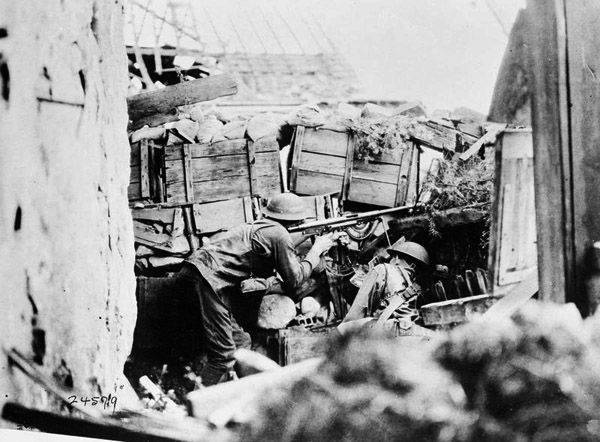
He also had another amazing feature - in the hands of an inexperienced machine gunner, with intensive shooting, the Shosh could suddenly break into two parts. The receiver and the cooling jacket around the barrel of the machine gun were mounted on a special metal frame, and were connected to it with virtually only one screw. As soon as the vibration screw was loosened or twisted, an incomplete disassembly of the French “automatic rifle” began.
Among the positive qualities of this weapon, in addition to its relatively small weight, can be attributed to its constructive simplicity and, consequently, cheap production. According to weapon experts, the Shosh design envisaged the use of low-cost steel and an uncomplicated production cycle (most of the parts were made on conventional lathes).
Commercial success technical failure
Despite all its flaws, the Shosh machine gun was a commercial success, albeit scandalous. In service with the French army, he remained until the 1924 of the year, and the total output of the machine gun at this point was quite a few 225 thousand.
Interest in the purchase of "Shosh" showed the army of many countries. The first, in view of the very sharp machine-gun "hunger", was Russia. However, the request of the Main Artillery Directorate of the General Staff to supply 1000 machine guns to the CSRG system in August 1916 was refused - "due to the enormous demand for these guns of the French army." Later, the Russian military department managed to place an order for the supply of 50 thousand “barrels”, which it was supposed to close no later than June 1917 of the year. But information on its actual supply varies significantly. According to the opinion of the arms specialist S. L. Fedoseyev, only 1917 thousands of CSRGs were sent to Russia until the middle of 3,2 year, in the materials of the military expert S. Monetchikov there are at least 20 thousand machine guns. Relatively small lots of the CSRG system were transferred to Belgium, Romania, Poland and Greece.
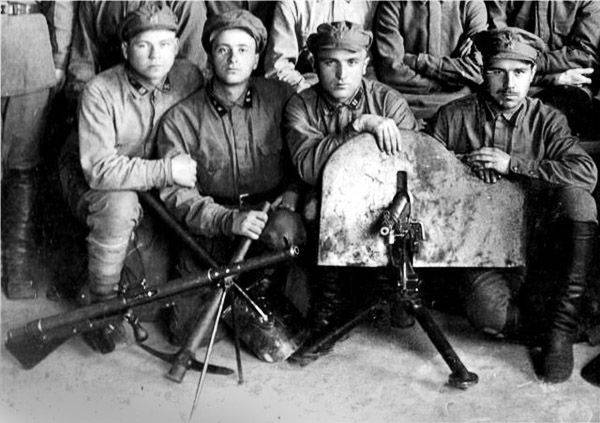
The French managed to get the main income from the sales of their machine gun-outsider from the US military, which had a very saturated market of automatic weapons. In the spring of 1917, shortly after America entered the war, General William Crozi, Director of the Arms Department of the American Army, signed a contract to supply almost 16 thousands of Shosh machine guns. It is noteworthy that several years earlier, the same official categorically rejected the idea of producing the excellent Lewis machine gun in the United States, but argued that the purchase of an obviously unsuccessful French model was "obvious lack of firepower of the American formations."
The result of its use in the US Army is not difficult to predict: the French machine gun received the same unflattering marks. Nevertheless, General Crozi continued to bulk purchases of these weapons. 17 August 1917, the Arms Commission of France received an order for another 25 thousand CSRG machine guns, only under the main American cartridge 30-06 Springfield (7,62 × 63 mm).
The fate of this contract was quite remarkable. Automatic Rifle Model 1918 (Chauchat) machine guns began to shoot even worse than those made for the “native” 8-mm cartridge. The more energy-powerful 30-06 munitions not only often jammed, but it also very quickly broke the recharge mechanism. It is not surprising that, having received a little more than 19 thousands of machine guns under a new contract, the Americans categorically refused further deliveries.
Several deputies of the French parliament then tried to initiate an investigation into where the profits from the sale of obviously useless machine guns to the Americans went, but it was quickly closed - too many high-ranking military and diplomats were involved in a deal on both sides of the Atlantic Ocean.
Capricious "weapon of victory"
This may seem surprising, but, being on the eve of the Great War a powerful industrial power, France failed to create its own school of small automatic weapons. All such systems received in the 1914 – 1918 period. into service with the French land army, were developed on the basis of technical ideas borrowed from the subjects of Austria-Hungary. Even the large family of machine-guns “Hotchkiss”, who had been in service for a long time and proudly called “victory machine guns” in France, were no exception.
At the end of the nineteenth century, the gifted Austrian German, Baron Odkolek von Augesd, developed an original automatic rifle automation system, working on the principle of removal of powder gases. It is important to emphasize that the work of von Auguse was conducted in parallel with the similar research of the American John Browning. But, unlike the latter, Auguse was not lucky - his machine gun turned out to be unclaimed in Austria-Hungary. The brainchild of the Austrian did not interest the Russian military department either. Then the baron sold the patent rights to his system to the American B. Hotchkiss, the owner of the French company “Hotchs and Company”.
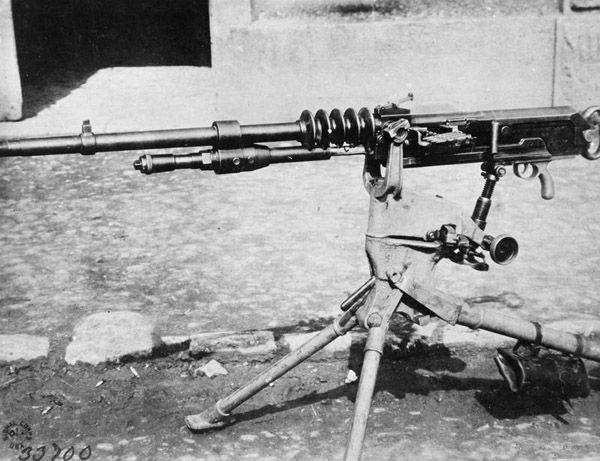
The engineers of this company, Lawrence Bene and Henry Mercier, finalized the Austrian system and in 1895, presented the “Hotchkiss automatic mitraliase” (machine gun in French - mitrailleuse. - RP) for field testing. In the same year, the famous “Browning Machine” by John Browning, the Colt-Browning Machine Gun M.XNXX, was adopted by the USA.
In 1897, the Hotchkiss machine gun with the M.1897 index was adopted by the French army. Its combat feed was carried out using a relatively short brass strip under the main French cartridge 8 × 50-mm R Lebel. A characteristic feature of the system was a large bronze radiator for cooling the barrel, as well as a firing rate regulator on the flue gas chamber.
Unlike Browning's Potato Digger, in which, by and large, there was nothing to break, the exhaust system and the reload mechanism of the Gochkis machine gun turned out to be capricious. According to experts, it was initially over-complicated, which inevitably led to frequent failures and breakdowns in field conditions. Overcoming these “generic diseases”, the French Defense Ministry undertook in 1905 – 1914. three machine gun upgrades, and carried them to different factories. So there were versions of Mle1905 "Putoto", Mle1907 "Saint-Etienne" and Mle1914 "Hotchkiss".
The latter was the most successful. From the most difficult and easily breaking parts freed. Helical reciprocating spring, which in previous types due to overheating was often the main cause of delays, was diverted from the barrel to the lower part of the receiver. Simplification touched even such important mechanisms as the fuse, which was simply abandoned.
The result of the intellectual assault of French engineers turned out to be contradictory. On the one hand, as weapon experts point out, the easel “Hotchkis M. 1914” turned out to be solid and very simple: it contained only 86 parts. (For comparison: the Austrian easel Schwarzlose consisted of 166 parts, and the Russian version of the Maxim machine gun had 282 details).
On the other hand, “Hotchkiss” turned out to be the longest machine gun of the Great War - together with a flame arrester of almost 2 meter (1940 mm)! The long “trunk” of the machine gun (775 mm) provided (especially before the strong warm-up phase) excellent shot ballistics, but due to the size of the entire system, unmasked the machine-gun “nest” to the position. The brainchild of the company “Hotchkiss” turned out to be quite heavy: along with the machine tool (without cartridges), the weight of the machine gun approached 50 kg.
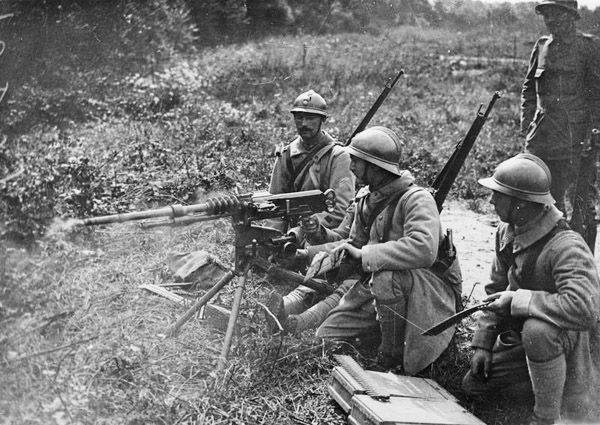
The capriciousness of the reloading mechanism of the Hotchkiss M.1914 system was never completely overcome: rigid metal tapes (strips on the cartridge's 24) sometimes stuck, even squeezed. The “semi-rigid” tape on 250 of cartridges from hinged links, as noted by the gunsmith S. L. Fedoseev, “did not give any gain either in the convenience of loading or in the rate of fire”.
The significant simplicity of the Hotchkiss system, despite the capriciousness in combat work, ensured its commercial success abroad. This machine gun was in service in 20 countries, including Spain, Greece, Brazil, Mexico. It was even sold to the United States - the recognized leader in the development of automatic weapons. The Expeditionary Corps of the US Army in Europe was armed with precisely these machine guns. Prior to 1, January 1917, the Russian front got about 540 machine guns "Hotchkiss", produced in factories in the UK.
Based on the Hotchkiss machine model, by further facilitating and optimizing the mechanisms in 1909 – 1914. a manual version of the machine gun was developed. In France, the manual “Hotchkiss” was adopted under the signature of Mitrailleuse Portative Hotchkis Mle.1909, but went into mass production only after 1 in August 1914.
Machine guns of this type in large numbers entered the arsenal of the British and American armies under the signature stamp “Bene-Mercier”. 30M. 1909. In the Russian army there were few "handbrake" systems of Hotchkiss and almost all were used in aviation.
The manual “Hotchkiss” had a good rate of fire (400 – 500 shots / min.), But a very significant weight in 12,25 kg without cartridges and a bipod. For comparison, the American "Lewis", considered heavy, in a similar condition weighed 10,63 kg, the Danish "Madsen" (with a loaded magazine for 25 cartridges and a bipod) - only 8,92 kg.
“As a light machine gun,“ Hotchkiss ”didn’t like any army,” the weapon expert S. L. Fedoseyev notes, “his service was more or less long only in the colonies.”
The entire Hotchkis family, despite its particular shortcomings, successfully overcame the front-line adversities of the First World War. The easel version in the mass number took part in the Second World War. The German Wehrmacht used the captured “Hotchkiss” under the designation MG.257 (f). The use of MG.257 (f) in battles with Soviet troops near Leningrad was documented.
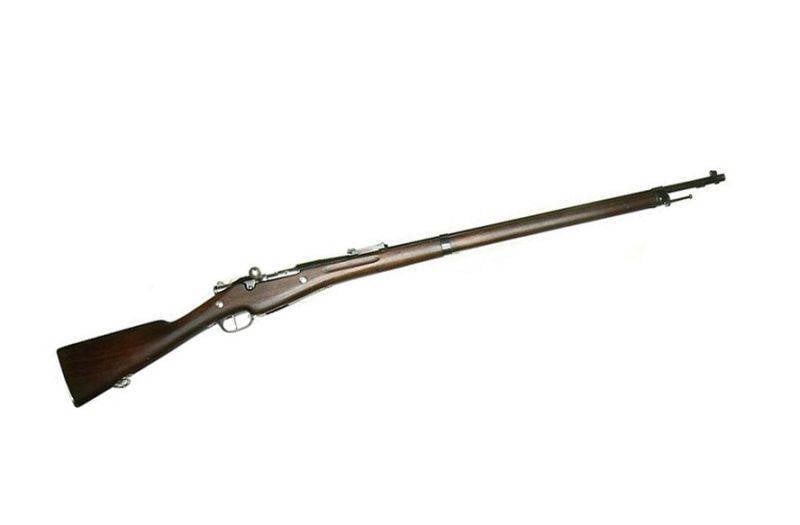
Information